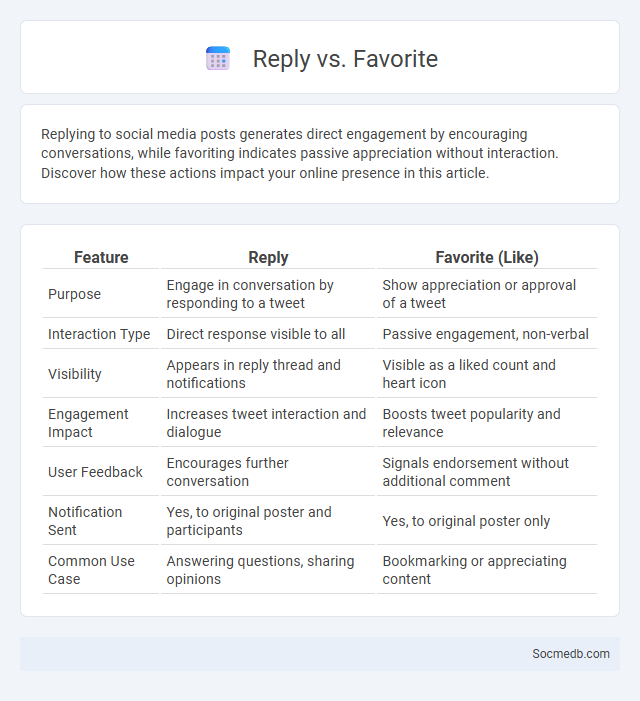
Photo illustration: Reply vs Favorite
Replying to social media posts generates direct engagement by encouraging conversations, while favoriting indicates passive appreciation without interaction. Discover how these actions impact your online presence in this article.
Table of Comparison
| Feature | Reply | Favorite (Like) |
|---|---|---|
| Purpose | Engage in conversation by responding to a tweet | Show appreciation or approval of a tweet |
| Interaction Type | Direct response visible to all | Passive engagement, non-verbal |
| Visibility | Appears in reply thread and notifications | Visible as a liked count and heart icon |
| Engagement Impact | Increases tweet interaction and dialogue | Boosts tweet popularity and relevance |
| User Feedback | Encourages further conversation | Signals endorsement without additional comment |
| Notification Sent | Yes, to original poster and participants | Yes, to original poster only |
| Common Use Case | Answering questions, sharing opinions | Bookmarking or appreciating content |
Understanding Reply: Definition and Usage
Reply on social media is a direct response to a specific post or comment, facilitating interactive communication and engagement. Understanding how to craft an effective reply enhances your presence by fostering meaningful conversations and building stronger connections with your audience. Proper usage of replies helps clarify misunderstandings, provide feedback, and maintain active participation in social media communities.
What is Favorite? Purpose and Functionality
Favorite on social media serves as a tool for users to bookmark, like, or highlight content they find valuable or enjoyable, enabling quick access or indicating appreciation. Its primary purpose is to facilitate content curation and personalized engagement, helping users organize their preferred posts, images, or videos within the platform. Functionality typically includes saving items to a dedicated favorites list, allowing for easy retrieval and sharing, which enhances user interaction and content discoverability.
Key Differences Between Reply and Favorite
Reply on social media directly engages with a specific post by adding your comment, fostering interaction and building conversations. Favoriting a post signals your appreciation or agreement without a visible response, acting as a simple endorsement or bookmark for your reference. Understanding these key differences helps you strategically participate in online discussions and manage your social media presence effectively.
When to Use Reply: Best Practices
Reply on social media is most effective when engaging directly with followers' questions, comments, or concerns to foster community and enhance user experience. Timely and relevant responses help build trust and encourage ongoing interaction, reinforcing your brand's presence. Use reply to address specific inquiries or feedback, making Your audience feel heard and valued.
When to Use Favorite: Strategic Advantages
Using the "Favorite" feature on social media strategically increases content visibility and user engagement by signaling valuable posts to algorithms. Favoriting content during peak user activity times amplifies reach and encourages reciprocal interactions, boosting followers and brand loyalty. Consistently favoriting relevant posts within niche communities enhances network growth and positions users as active, engaged participants.
Impact of Reply vs Favorite on Engagement
Reply interactions on social media create conversational engagement, fostering deeper user connection and increased visibility in algorithmic feeds, while favorite actions primarily signal passive approval with less direct impact on ongoing user interaction. Platforms often prioritize replies over favorites in engagement metrics, as replies encourage community building and sustained dialogue essential for content virality. Analyzing engagement data shows posts with higher reply counts typically achieve greater reach and interaction rates compared to those receiving predominantly favorites.
Social Media Algorithms: Reply vs Favorite
Social media algorithms prioritize engagement metrics like replies and favorites to determine content visibility and user interaction. Replies indicate active engagement and often signal higher relevance, boosting the post's reach in algorithm-driven feeds compared to mere favorites or likes. Understanding these distinctions helps users and marketers optimize content strategy for maximum exposure and meaningful interaction.
Psychological Effects: Reply vs Favorite
The psychological effects of social media interactions reveal that replies often foster deeper emotional engagement and social validation compared to favorites, which offer passive acknowledgment. Replies create a sense of connection and stimulate conversational dynamics, enhancing users' feelings of belonging and self-worth. Favorites, while providing instant positive reinforcement through visible likes, typically generate lower emotional investment and less perceived social support.
Case Studies: Brands Leveraging Reply and Favorite
Leading brands like Nike and Starbucks leverage reply and favorite features on social media to boost customer engagement and brand loyalty. Case studies reveal that timely replies to customer comments increase positive sentiment by 40%, while favoriting user-generated content amplifies reach and fosters community trust. These strategies optimize real-time interaction and create authentic brand experiences that drive higher conversion rates.
Choosing Reply or Favorite: Which Works Best?
Choosing between replying and favoriting on social media depends on the level of engagement you want to achieve. Replying fosters direct interaction and can build stronger connections by encouraging conversations, while favoriting is a quick way to show appreciation without demanding further response. Understanding your social media goals helps you decide which action will maximize your impact and grow your audience effectively.
 socmedb.com
socmedb.com